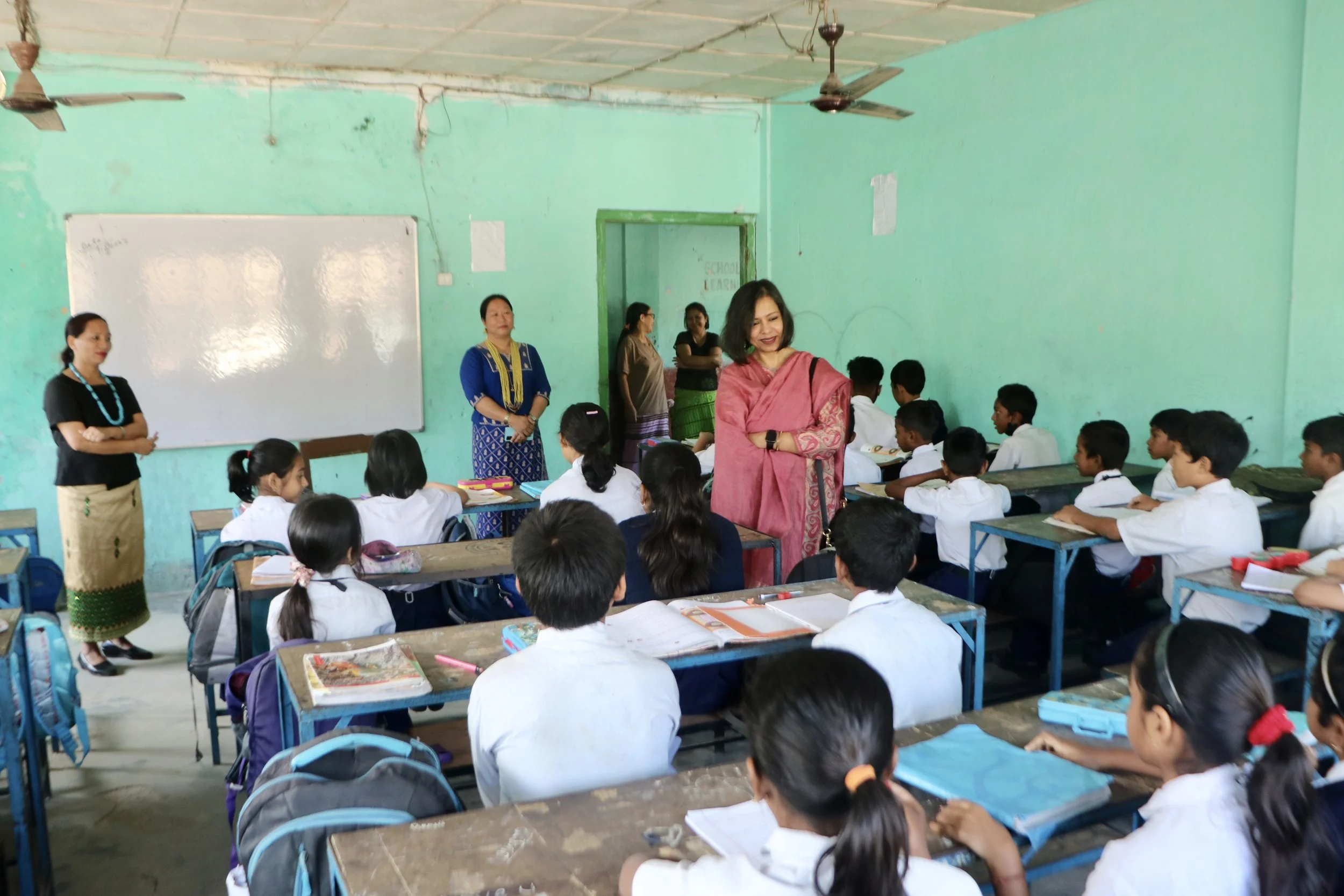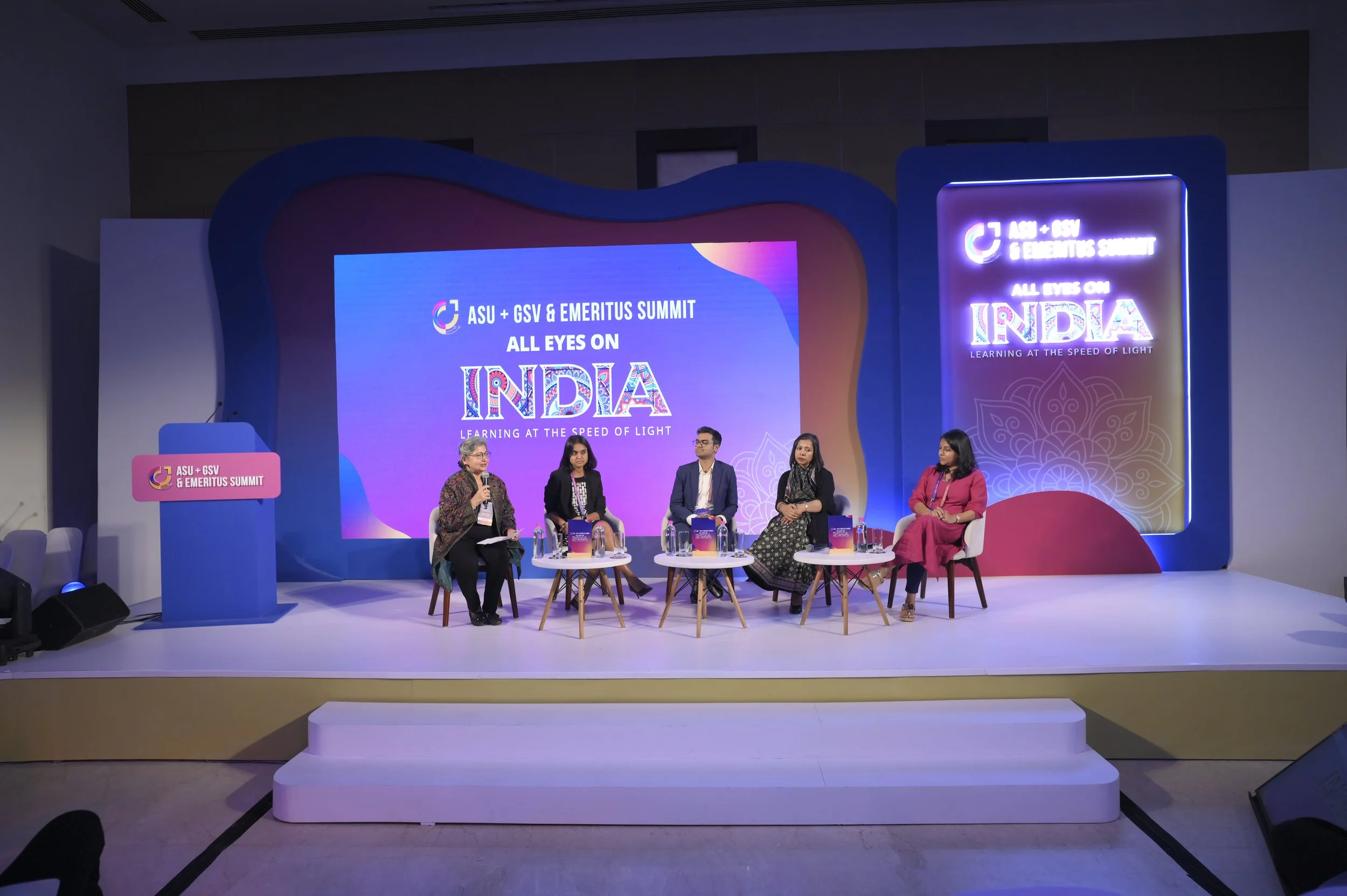Ratna Viswanathan On Scaling Education Reform Through Government Partnerships And Empowering Teachers
Ratna Viswanathan is a distinguished leader with over 35 years of diverse experience in civil service, development, microfinance, environment, and education sectors.
A 1987-batch civil servant from the Indian Audit and Accounts Service, she holds a Master of Arts degree in English Language & Literature from the University of Lucknow. After two decades in the Government, she voluntarily transitioned to the development sector, holding leadership roles with organisations such as Oxfam India, VSO, MFIN, UNEP, and UNDP.
Since 2020, Ratna has been leading Reach to Teach as the first Indian CEO, focusing on strengthening learning outcomes Government schools. Drawing from her background as an auditor with the Comptroller and Auditor General of India (C&AG), she brings a systems-thinking lens to education reform.
A passionate advocate for teacher agency and joyful, competency-based learning, she works to make learning engaging and meaningful for all children. Ratna also serves as an Independent Woman Director on several Boards, contributing strategic insights to build impactful public-private collaborations.
Ratna discusses driving systemic change in education by strengthening teacher agency, why collaborative government partnerships are essential for scaling impact, and improving learning outcomes in India’s public schools.
Highlights from the interview (listen to the podcast for full details)
[Indio Myles] - To start off, can you please share a bit about your background and what led you to work in education and impact?
[Ratna Viswanathan] - I call myself a chameleon because I’ve worked across so many sectors, and I think that comes from my restlessness to learn. I started off as a civil servant purely by accident, with no plan in sight. Then later, again, with no clear plan, I voluntarily quit the services after about 21 years.
Since then, I’ve worked across different sectors. There has been core development, microfinance, and intergovernmental agencies like UNEP and UNDP, and now education. For the last five years, I’ve been working in education. I used to know it from the other side when I was auditing everything, but now I see it from the perspective of executive decision-making and outcomes; very different lenses.
As the CEO of Reach To Teach, can you share more about the organisation and how it is strengthening learning outcomes in government schools across India?
To put it in a broad and brief way, we began working in India in 2007. Reach To Teach emerged from the philanthropic vision of its founder, Sanjeev Gandhi, a British born Asian person whose parents migrated from Gujarat. With a strong spirit of giving back to the country his parents came from, he started Reach To Teach.
It began very simply, with two buses carrying cooked food into tribal districts of Gujarat, where children were out of school. The idea was to attract them into the buses to learn while being provided food. That’s where it started, driven by the noblest of intentions, and it has since gone through several evolutions.
From there, the focus shifted to working with government schools, but at the community level. We engaged with communities and teachers, and looked at the whole process of teaching and learning from the bottom up. Field-level engagement ensured that we understood what was happening on the ground.
Over time, this grassroots work kept evolving, and we started working with partners who implemented strategies and designs we developed together. By the time I joined in 2019, the organisation had begun working more directly with the Government of Gujarat, the same state where it all began in 2007.
I realised, however, that much of the engagement was about putting our people to work alongside government officials, and from where I come from, I felt that wasn’t the best use of resources.
We developed a strategy where our focus became strengthening teaching and learning outcomes in government schools, which are typically low-resourced due to their sheer number. More than half the children in this country, often from lower-income households, attend these schools. We knew that if you want to achieve scale, the only way to do it is by working through government infrastructure and outreach. No matter how deep your pockets are, you can never match that level of reach.
We signed memorandums of understanding with different states. We began with Gujarat and then expanded into three more states, so today we are in four: Gujarat, Haryana, Meghalaya, and Uttar Pradesh.
Gujarat and Haryana are very urban states, while Meghalaya and Uttar Pradesh are in the distant northeast of India. These states are hard to access, with difficult terrain and low-density populations, but we took this on as a challenge.
Our philosophy was that in the urban states, civil society representation was already quite strong. We wanted to focus on states that were still working to improve their education indicators, but where civil society engagement was less intense.
Since 2020, we have been working entirely with the government, and our focus is on systemic strengthening, scale, and sustainability. The way we do this is by embedding within the education department after signing the MOUs, and then working from the inside.
What sets us apart is that our design thinking derives from a place of empathy. While it is wonderful to say children are at the centre, the reality is that children do not have agency. Agency is created by their ecosystem, and at the heart of that ecosystem is the teacher. That’s why we began our entire design process by consulting teachers, asking them what works, what doesn’t, and what they need to strengthen learning outcomes, textbooks, and teaching materials.
We also consult at every level of the education department, because senior officials rotate every three years. To maintain stability, everyone has to be involved. This consultative approach has allowed us to design teaching materials in the most credible way, accounting for local culture, context, and understanding.
More importantly, we’ve been able to secure the buy-in of both teachers and the education department. That means when we step away, the work is sustainable, because it becomes institutionalised.
Why is teacher agency so important in creating joyful, competency-based learning environments, and how is Reach to Teach nurturing this?
I think there are two important factors. One is, of course, engaging directly with teachers as I mentioned earlier. The other is recognising that children are naturally curious. If you subject them to rote learning, that critical curiosity isn’t sparked. Without curiosity, you don’t really learn; you just memorise.
We realised nobody understands a child in their class better than the teacher does. Children spend six to eight hours a day with their teachers, often more time than they do with their parents while awake. Teachers truly know their students, and not harnessing that intuition and understanding would be disregarding an enormous wealth of knowledge. That’s why we decided to make teachers central to our design thinking process.
We asked: What would work for children? What wouldn’t? We also brought in elements of touch, feel, see, and hear, ensuring that learning is intuitive, hands-on, and experiential. This kind of learning naturally leads to competency-based outcomes, because when you understand something, competency follows. Without understanding, it’s just rote learning.
Taking all these factors into account, we created activity-based and experiential materials, but not random ones. First, we conduct an assessment of learning gaps. Then we design materials linked directly to those gaps, ensuring they are grade-appropriate and subject-appropriate, so children can reach grade-level learning.
During the process, what really made a difference was the teachers’ buy-in and their complete acceptance of the design elements and activities we created. We’ve conducted extensive training and, importantly, we remain present in the states where we work to provide ongoing support. There’s no “helicopter model” where you fly in, train, and then fly out again. We stay, we hold hands until the very end.
We work alongside teachers to co-create and deliver training so that there is a shared understanding across the system. What also makes this effective is that once we design the modules, we produce very detailed teacher handbooks. This means that if a state has, say, 3,000 schools, every single one of those schools can roll out the activity in exactly the same way.
It is critical that teachers lead this work and fully understand it, because only then can learning outcomes be strengthened at scale. For us, teachers are absolutely the fulcrum of improving education within the public school system. When a teacher feels seen, heard, and validated, the level of buy-in is immense. That’s what we leverage, and it’s why there is so much focus on teacher agency.
What have been the biggest challenges and successes you’ve encountered when bringing education initiatives to complex environments?
The biggest challenge is getting the government to accept you as a trusted partner and a partner of choice. Until that happens, you can never truly become part of the system. If you aren’t part of the system, anything you design remains external and risks being derailed by local-level administrative functionaries.
What has helped us gain inside access is the fact we work with government as true partners, without constantly talking about ourselves or what we’ve achieved. The only way to reach scale is through government and its outreach. That’s what we do: we design and train, but government functionaries implement.
I don’t implement directly; my team is very small (just four people in a state) but the entire education department machinery is part of implementation. Teachers themselves are the drivers. We also create district-level task forces for classroom supervision and oversight. In this way, the system runs it, which is how scale is achieved.
The successes have been deeply rewarding. In one of the states we worked in, exam performance improved by 10% in the 10th grade and 12% in the 12th grade within a year. Cumulatively, the improvement has now reached 16% and 18% in the second year. Clearly, something is working. Children are learning, and importantly, they are learning through understanding rather than rote memorisation.
There’s no better third-party validation than government figures. They’re not mine, they’re not discretionary, but they’re in the public domain.
Working with government comes with challenges. There are constant policy changes and frequent personnel changes, which makes it a vulnerable space for a not-for-profit organisation. But once you build the relationships and establish trust, it’s the only place to be if you truly want to bring systemic change. That’s where change can be driven at scale, because the system is leading it and not you. Once the system owns it, it becomes embedded, sustainable, and able to continue long after I step away.
Are there strategies you believe are effective in advancing and creating more opportunities for female leadership within the social change sector?
There definitely are. The biggest constraint I see is that we still adhere to gender stereotypes. You’ll find many women in the teaching field, far more than men, yet the heads of schools are usually male teachers, with few women in those leadership positions.
What I believe we need to embed leadership skills into regular training processes, rather than offering them as stand-alone modules that sit outside the system. Women, I think, are often able to correlate nurturing with strengthening. This isn’t to say men don’t have those abilities as well, it’s just in the nature of things women often bring a more intuitive approach. This is particularly with empathy, which is absolutely critical to learning.
people often talk about AI in education. But if a child falls in the playground and grazes their knee, no AI is going to come and hug that child. You need a human being. AI is a powerful tool, but it will always remain just that, a tool. It can never replace human empathy. Women, especially with younger children, play a vital role in providing that nurturing presence.
For example, whether men or women, teachers are often the ones we rely on to support children dealing with anxiety or stress around examinations. Yet women can easily get left behind in the narrative.
If we could build the leadership quotient of women teachers, helping them own their space, their work, and their solutions, not just as implementers but as creators and leaders, that would significantly strengthen the sector.
People often talk about glass ceilings, but in government I don’t think it’s as pronounced as in the private sector. In government, the focus is very much on performance and results. Yes, gender bias exists, but not at the same level you often see in private industry.
What advice would you give to emerging changemakers who want to create systems change, inspire progress, or build collaborations with government?
My simple response would be: listen.
Listening is the most important skill we can bring to the table if we truly want to drive change. There is already a vast body of information, approaches, frameworks, and tools out there, but each has been created within a specific construct. Not all of them apply to every context. That’s why it is critical to listen. Real change has to be participatory. It must be an effort where all the people and agencies involved feel equally heard, equally valued, and equally invested.
When every component of change is engaged in the process of driving it, that is when true transformation happens.
What inspiring projects or initiatives have you come across recently creating positive change?
There are many agencies in India working in this space, but I’d really like to highlight Educate Girls. They began in 2011 and have been working with marginalised communities and girls across different parts of the country, particularly those who are socially excluded.
As a country, it is a matter of great pride that Educate Girls was recently awarded the Ramon Magsaysay Award. This is significant because while individuals from India have received the award many times, this is the first time an Indian not-for-profit organisation has been recognised in this way.
It’s a brilliant achievement because it brings the lens back onto children in low-resource schools from low-income backgrounds. I believe this kind of recognition will help move the entire agenda, narrative, and conversation on education equity forward.
To finish off, are there any books or resources you would recommend to our audience?
I’m an intermittent reader. I read all kinds of books, often four at a time, because every time I get onto a flight, I start a new one! There isn’t just one book I would point to, but I deeply believe in the philosophy of the Indian thinker Jiddu Krishnamurti, who also has a strong global standing.
Krishnamurti wrote extensively about education. His work is intuitive, profound, and still incredibly relevant today. Much of it comes from his lectures and conversations, but the brilliance of his mind shines through in his reflections on how we think about learning.
If someone is looking to understand the philosophy of education in a deeper sense, I would wholeheartedly recommend his writings.











